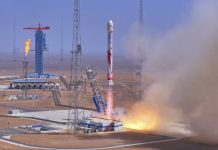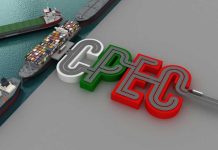By Abdul
Rashid Shakir
Rightly dubbed as buckle in the belt, China Pakistan Economic Corridor (CPEC) is a flagship project of China’s Belt and Road Initiative (BRI), as it connects overland Silk Road Economic Belt with 21st Century Maritime Silk Road, two major components of this ambitious infrastructure development project, aimed at better economic linkages for prosperous future of around 63% of world population hailing from 65 countries of South East Asia, South Asia, Central and Western Asia, Middle East, Europe and Africa.
Launched in 2013 by the Chinese President, Xi Jin Ping, as One Belt One Road (OBOR) and rebranded in 2016 as Belt and Road Initiative (BRI), it is a remarkable regional connectivity project in the Afro-Eurasian region to promote cross cultural and trade ties by developing transport and communication infrastructure. Envisioned as a multi-trillion dollars project with rich economic dividends for both China and 65 other participating countries of the South East Asia, Central Asia, West Asia, Africa and Europe, it involves construction of roads, rails, sea ports, oil and gas pipelines, optic fiber connectivity, special economic zones (SEZs), cross border trade and cooperation centers. Besides building hardcore infrastructure, it also aims at negotiating preferential and fee trade agreements, besides the introduction of effective legal structure and system of courts to settle trade-related disputes between the countries involved.
Silk Road Economic Belt of the Belt and Road Initiative (BRI) has six economic corridors. They include China-Mongolia-Russia Economic Corridors, China-Central Asia-West Asia Economic Corridor, Eurasia Land Bridge Economic Corridor, Bangladesh-India-Myanmar Economic Corridor, China Pakistan Economic Corridor (CPEC), and China-Indochina Economic Corridor. On the other hand, 21dt Century Maritime Silk Road, its second component, aims to connect South East Asia, the Indian Subcontinent, the Arabian Peninsula, Africa and Europe with China through maritime trade lines. It extends from China’s Fuzhou sea port on its Eastern coast to Rotterdam sea port in the Netherlands through South China Sea, Western Pacific Ocean, Strait of Malacca, String of Pearls in the Indian ocean, Port of Djibouti in the Red Sea, Suez Canal, and ports of Piraeus and Venice in the Aegean and Mediterranean Seas respectively. It includes construction of shipping ports, hydro-carbon refineries and industrial parks. Together these amount to around 1700 projects worth more than $1 trillion.
In order to finance such a huge infrastructure spending, China has established a new multilateral financial institution, Asian Infrastructure Investment Bank (AIIB). With the initial capital of $100 Billion, it aims to lend money for economic projects under BRI. Another key financial institution in this regard is Silk Road Fund under China’s Central Bank. With $40 Billion in its kitty, it invests in BRI projects instead of lending money for them. Moreover, China Development Bank and Exim Bank of China are the biggest contributors of BRI projects, with the earlier committing $ 890 Billion over a span of several years. Besides all these financial institutions, China’s staggering foreign exchange reserves of $ 3.7 Trillion, and its Sovereign Wealth Fund of $ 220 Billion also offer stable financing platforms for this funds-intensive infrastructure development project of modern times. Evolving from Deng Xiaoping’s ideal of maintaining a low profile to Xi Jin Ping’s flexing of economic muscles at international front, Belt and Road Initiative (BRI) revives the application of Halford Mackinder’s Theory of Eurasian Heartland and Alfred Mahan’s Theory of Maritime Rim land, which advocate respectively that one who controls the Eurasian heartland controls the world, and the one with power in maritime fronts and countries of the world controls the world. In the same way as Bretton woods System is America’s Global Soft Power Policy, Beijing intends to replicate that soft power experience in Asia with Belt and Road Initiative (BRI). Moreover, China is building ports, roads, railways and pipelines in the Indian Subcontinent to bypass maritime choke points in the South China Sea and Western Pacific Ocean, because 90% of China’s international trade passes through sea lanes not in control of China. Yellow Sea, East China Sea, South China Sea, and Pacific ocean have strong presence of US Navy. 80% of China’s crude oil imports pass through strait of Malacca, a maritime choke point connecting Western Pacific and the Indian oceans, the area dominated by American and Indian navies. BRI serves as a contingency plan that diversifies foreign trade routes between Chinese cities and global markets in the Afro-Eurasian region.
China Pakistan Economic Corridor (CPEC) is one of the most significant infrastructure development project of BRI worth over $60 Billion. Launched in 2015, it is modeled on one plus four layout of cooperation. It means, besides the construction of highways, railroad and pipelines linking Kashgar/Xinjian in Western China with Gwadar port on Arabian Sea in the South West of Pakistan, CPEC is focused on developing energy infrastructure, simulating industrial development, enhancing agricultural yield through modernization, contributing to socio-economic growth by establishing Special Economic Zones (SEZs), and ensuring better regional connectivity by laying optic fiber between the two countries. It also involves developing a modern deep-water port, International airport, water desalination project, an oil terminal, petrochemical complex, a coal-based power generation plant and allied facilities at Gwadar. Under this project, Gwadar is going to be a hub of Chinese economic ties with the Middle East and North Africa. China is, therefore, investing liberally in the development of this region. In 2015, China converted a $ 230 Million loan for the development of Gwadar into a grant. Moreover, $ 140 Million loan to develop 19 KMs East-Bay expressway to connect Gwadar with the coastal highway was converted into interest-free loan. Pakistan has granted China 40-year lease to operate Gwadar port. A coordinated China Pakistan Master Plan for Gwadar depends heavily on Public Private Participation (PPP) for the promotion of industrial and commercial activities through private and international investment. Government of Pakistanis has announced special investment and tax incentives for Gwadar Special Economic Zone (SEZ).
Major initiatives of CPEC include 2700 KM-long road network extending from Gwadar port to Khunjrab Pass through KKH in the Karakoram mountains of Gilgit Baltistan, overhauling of KKH from Hasan Abdal/Punjab to Chinese border/Khunjrab, construction of 1100 KM-long Karachi- Lahore Motorway, upgradation of 1687 KM-long ML-1 railway line extending from Karachi to Peshawar for modernization of transportation network, development of a dry port in Havelian/KPK, 820 KM-long China Pakistan Cross Border Fiber Optic Project (Rawalpindi- Khunjrab), around 10,000 MW power generation projects, 660 KV HVDC Matiari-Lahore transmission line, and network of pipelines to transport LNG and oil including a $ 2.5 Billion Gwadar-Nawab Shah pipeline to transport gas from Iran.
Funding for these CPEC projects is a mix of grants, concessionary loans, and private sector Investment. 20% of more than $ 60 Billion funds comprise debt-based financing, whereas 80% are investments in Joint Venture (JV) enterprises between the two countries. Pakistan’s debt to GDP ratio is more than 80%, whereas CPEC loans are around 6% of the GDP. Pakistan secured
$ 5.874 Billion worth of concessional loans from China on 2% mark up for the construction of energy, rail, roads, Orange Line and Motorway projects. CPEC is expected to be fully operational by 2023, whereas repayment of Chinese loans will start in 2022.
Along with incurring debt liabilities, the potential benefits of CPEC for Pakistan’s economy are also worth mentioning. It is estimated that CPEC will generate $ 6-8 Billion per annum just in taxes as roads and bridges tolls. Road infrastructure projects are estimated to create 51,000 jobs, more than 94% of which are specifically for Pakistanis. Pakistan and China Joint Venture (JV) projects are estimated to create 1.2 Million job opportunities, more than 33% of which would be exclusively for Pakistani citizens. Overall 2.3 Million jobs are expected to be created (2015- 2030), resulting in more than 2.5 % annual rise in GDP. Moreover, the national economy will be in a position to manage around 3.5% annual GDP loss due to poor and dilapidated communication infrastructure, and 2-2.5% annual GDP loss due to power outages in the country.
Even a cursory glance at the facts above belie misleading propaganda by a section of Western and Indian media that equate Chinese loans and investments under the CPEC with debt trap diplomacy of China to extend its economic and political influence in the region. Instead, CPEC is a win-win project of China Pakistan economic cooperation. Besides diversifying Chinese supply lines, it would prove to be a catalyst for the socio-economic development of Pakistanis.
-The author can be reached at arshakir.pmo@gmail.com





